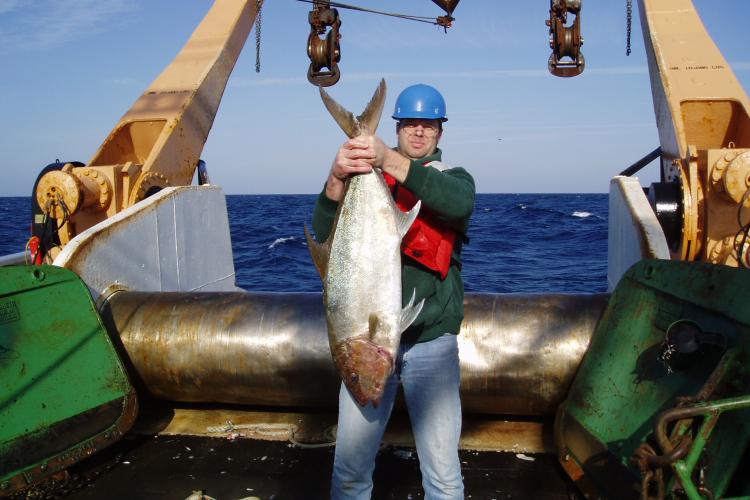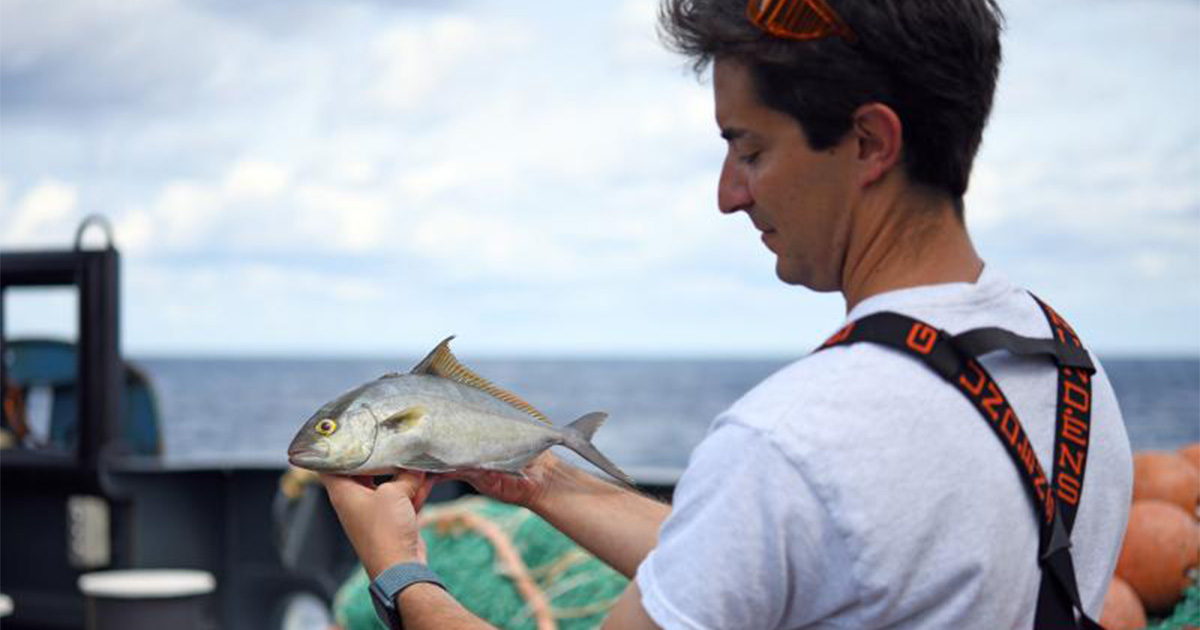NOAA Fisheries, the National Systematics Laboratory, and their partners use contemporary survey data to shed new light on historical data and the life histories of four species of amberjack in the western North Atlantic.
In September 2012, fishery biologist John Galbraith sailed on the Northeast Fisheries Science Center’s biannual bottom trawl survey of the western North Atlantic. He didn't expect that eight unusually large fish caught during that survey would set in motion a study that would require 10 years, multiple collaborators, and thousands of historical data points to complete.
The Northeast Fisheries Science Center conducts two bottom trawl surveys each year during the spring and the fall. This effort is one of the longest running standardized trawl surveys in the world, and has been carried out continuously since 1963. Researchers use these trawls to help estimate biodiversity, abundance, and distributions of species. Today, the survey area stretches from Cape Hatteras, North Carolina to the Gulf of Maine, encompassing much of the western North Atlantic.
 Map of the area that is surveyed by the Northeast Fisheries Science Center bottom trawl in the Atlantic Ocean. Today, the survey area (highlighted in yellow) spans from Cape Hatteras, North Carolina to the Gulf of Maine. (Image credit: Dr. Katherine Bemis)
Map of the area that is surveyed by the Northeast Fisheries Science Center bottom trawl in the Atlantic Ocean. Today, the survey area (highlighted in yellow) spans from Cape Hatteras, North Carolina to the Gulf of Maine. (Image credit: Dr. Katherine Bemis)
Four species of amberjack (greater amberjack, lesser amberjack, almaco jack, and banded rudderfish) are found within the bottom trawl survey area. Though amberjacks are relatively uncommon in this region, their presence in bottom trawl surveys over the years is consistent enough to draw meaningful conclusions about their distributions.
As adults, these species can look similar to one another, which makes it difficult to differentiate them in the field based on physical characteristics alone. This creates a challenge for researchers, and can potentially lead to the misidentification of amberjacks caught during the survey.
The Quest for Certainty
Galbraith witnessed such a scenario firsthand during the fall 2012 bottom trawl survey when researchers hauled in eight huge amberjacks. Their large size suggested that they may be greater amberjack. Galbraith, however, had a hunch that these were actually unusually large specimens of lesser amberjack, one of the smaller amberjack species. So, he set out on a search for answers.
“My quest to identify those specimens turned into a study which got larger and more interesting—enough so to attract collaborators,” Galbraith says. They included Northeast Fisheries Science Center colleague Dr. Mark Wuenschel and Dr. Katherine Bemis of the National Systematics Laboratory in Washington, D.C., as well as Dr. William Bemis and Heath Cook from Cornell University.
The team used the historical trawl database of the Northeast Fisheries Science Center to learn more about the life histories and distributions of the four species of amberjack in the western North Atlantic. However, Galbraith knew the challenges of differentiating between amberjack species. Keeping this in mind, they decided to investigate the effect of potential misidentifications on historical survey data.
To do this, they examined 105 amberjack specimens collected by bottom trawl surveys between 2006–2019. They compared assignment of species at sea to in-lab identifications, which were confirmed using genetic sequencing and identification keys. This allowed the team to determine the percentage of accurate at-sea assignments for each species among the 105 examined specimens. What they found was that success of at-sea assignment was dependent on the species:
- 100 percent success for lesser amberjack and almaco jack
- 91.67 percent for banded rudderfish
- 24 percent for greater amberjack
“We now can be confident about the historical data for species that have correct at-sea assignments of more than 90 percent, which means these fish are being accurately assigned to a species at sea most of the time,” says Dr. Katherine Bemis. “Overall, our findings show that the survey data are high quality, but certain species are more likely to be misidentified, so species with lower successful identification rates, like greater amberjack, should be examined in the lab to confirm their identity. Species have different natural histories, such as maximum size or age at maturity, so it is important to correctly identify them. If biological data for multiple species is mixed, it can lead to incorrect conclusions."
 John Galbraith holds an almaco jack on the deck of NOAA Ship Albatross IV during one of the Northeast Fisheries Science Center’s bottom trawl surveys. (Image credit: Northeast Fisheries Science Center Historical Photographs)
John Galbraith holds an almaco jack on the deck of NOAA Ship Albatross IV during one of the Northeast Fisheries Science Center’s bottom trawl surveys. (Image credit: Northeast Fisheries Science Center Historical Photographs)
Not-So-Lesser Amberjack
Genetic sequencing and anatomical examination in the lab revealed the eight large unidentified amberjack specimens to be lesser amberjack, confirming Galbraith’s original suspicion. In fact, these specimens all exceeded the previously recorded maximum length for lesser amberjack. One of them set a new fork length record of 76 centimeters—not so “lesser” after all!
The team then used their findings to interpret the historical records in the survey database, helping better understand the life histories and distributions of these four species. “In cases like this where species are hard to identify, the accuracy of historical data and accounts needs to be verified in context when possible,” says Wuenschel. “Our search of the literature and reevaluation of museum specimens allowed us to draw conclusions with more confidence than simply ‘mining’ more readily available data.”
Based on their analyses, the team reached a number of significant conclusions. “We see a consistent presence, similar size range, and relative abundance of the species dating back to the 1800s for greater amberjack and banded rudderfish,” Galbraith says. “We also documented the presence of the historically overlooked lesser amberjack in the region, which impacts the evaluation of climate change-induced range expansion. In other words, lesser amberjacks were present in the region but misidentified as other species, not that they only recently began to occur in the region.” Additionally, the team found evidence that juvenile banded rudderfish may use northern habitats, including this region, as nurseries.
Teamwork Makes the Dream Work
While collaboration is an important component of any study, it was particularly important in this case. This research required analyzing multiple large datasets and examining various aspects of amberjack life histories, such as distribution, abundance, and seasonality. Involving scientists from different areas of expertise and institutions made the study more comprehensive, Bemis emphasizes. It allowed them to delve deeper into certain topics, such as the reproductive biology of amberjacks, that they would have been unable to pursue otherwise. “This team’s breadth of knowledge is what pushed this paper across the finish line,” Bemis says.



